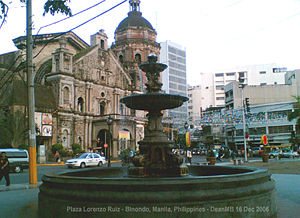Revisited Binondo last Sunday, with my fellow aspiring travel photographers. With DSLR cameras around our necks, and feeling like a bunch of tourists lost in the jungle called Chinatown, we had the people around the area freely posing for us.
I was pleasantly surprised by how accommodating and gracious the people were, from sidewalk vendors to store owners, side-car pedallers to kalesa drivers, even the security guards were quite helpful – not to mention the roving policeman, who posed nonchalantly while he answered some of our questions.

 Plaza San Lorenzo Ruiz and the Binondo Church
Plaza San Lorenzo Ruiz and the Binondo Church
We met at 6:00 a.m. in front of Binondo Church, aka Minor Basilica of St. Lorenzo Ruiz. Mass was going on and around us were sampaguita vendors peddling, street children begging, all with smiles on their faces. Walking along Ongpin towards Salazar Street, we saw the neighborhood stirring. Newspaper boys were loading the news sheets onto their bicycles, fruit vendors were displaying their wares on their karitons, bakers were rolling their doughs ready for the oven and sidecar pedallers were waiting for their first passengers.
We had a hearty breakfast of kiampeng (fried rice) and kikiam (deep fried ground meat wrapped in tofu skin) at Cafe Mezzanine Volunteer Firemen’s Coffee Shop, wherein part of their proceeds are donated to the volunteer fire fighters of Binondo.
Binondo streets are known to be narrow and fire trucks from other areas have had difficulty entering the vicinity whenever a fire hits. Therefore, the residents came up with their own fire fighting units; the most famous of these are the purple colored fire trucks donated by Eng Bee Tin Hopia Factory.
We walked back to Plaza Lorenzo Ruiz and started our first photo project. It was creatively challenging and the stifling weather made it more so. Patience was stretched to the limit that morning, as the assignment was titled. Starbucks beckoned. Apparently, Starbucks Binondo, located across the street from the plaza, was one of the first branches worldwide to offer a menu with Chinese translations and a Chinese signage.
After quenching our thirst and answering nature’s call, off we went to our next assignment. My buddy and I decided to hit Ongpin Street. It was mid-morning, the street was relatively quiet. There was no traffic, the pedestrians were very relaxed, a far cry from the hustle and bustle Chinatown is known for. Lunch was at Tasty Dumplings, where we had their famous battered fried pork chop, hongma with kiamchay (braised pork belly with salted vegetable in pot) and deep fried silver roll, (deep fried bread to lap up the sauce of hongma) all downed with a tall ice cold bottle of – water.
Off again to our next assignment. We were confined to shoot along Salazar Street, where the fruit vendors were. Lucky for us, we found our subjects in a quaint little air-conditioned charm store, right smack in the middle of the fruit stalls, selling all sorts of oriental idols, Buddhist prayer beads and lucky charms. They even had a beautiful Buddhist altar, complete with water falls and fountains, at the back of the store. The gentleman at the counter was most gracious and allowed us to shoot away. My target was the Buddhist Singing Bowl displayed on the countertop.
The next assignment was an artistic challenge because we had 45 minutes to take only four shots, no more, no less. We walked around the block to find our composition. We started from Salazar corner Benavidez Street, walked towards Masangkay, turned right and headed towards Soler. Along the way, we met a group of street children playing, who caught sight of our cameras and gamely posed for us and there we took some great shots. We turned right again from Soler Street, which brought us back full circle to Benavidez Street.
Our final task was to take scenes of Binondo as a travel destination. Instructions were received at the final pit-stop, the Golden Fortune Tea House along Masangkay Street. Everybody was hot, tired and weary. All I could manage was a tall glass of ice cold lemon tea and a fruit platter I shared with a friend. As we cooled our heels, we started to compare notes and share our experiences.
To cap the day, and shoot our last shot from a different perspective, I decided to share a kalesa ride with a friend who hadn’t been to Binondo in a long time. I myself hadn’t ridden in one in years. For Php200, we started our ride from Plaza Lorenzo Ruiz and headed towards Ongpin. We turned left at T. Alonzo Street straight to Claro M. Recto. From there, we turned right at Rizal Avenue, right again on Ronquillo, passing Plaza Santa Cruz. We then made a left at Dasmarinas Street, left again at Nueva to take us to Escolta. From Escolta, we rode to Carriedo, which brought us back to the other end of Rizal Avenue. We went through Ronquillo again and passed Plaza Santa Cruz. We hit Tetuan and turned left at Gandara until we reached Quintin Paredes and rode back to Plaza Lorenzo Ruiz. (Whew!)
Binondo for a day as a tourist/photographer was an unforgettable experience. It opened my eyes to the unique sight, sound and smell of a true Chinatown. I realized how friendly the people were, how culturally rich the locales were and the abundance of food to taste was unimaginable. I accomplished things I never thought possible and relived experiences long missed.
I realized Binondo was a representation of myself – brought forth from Chinese roots and shaped by Filipino hands.